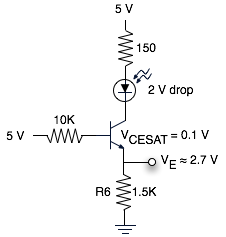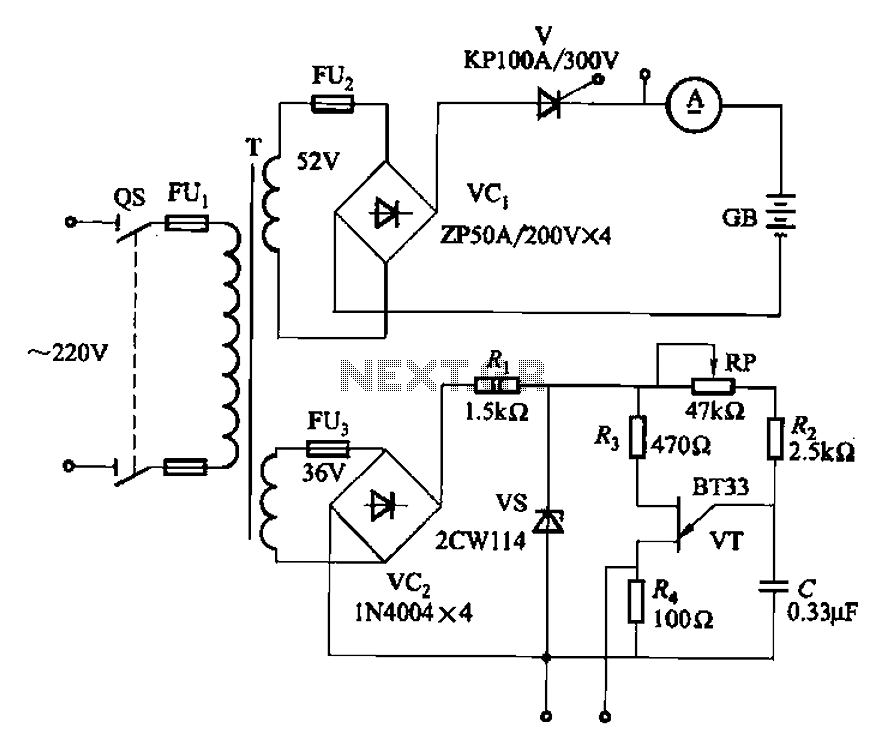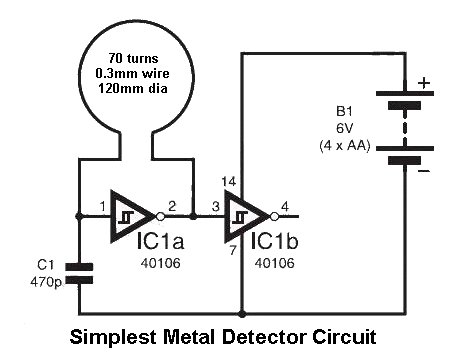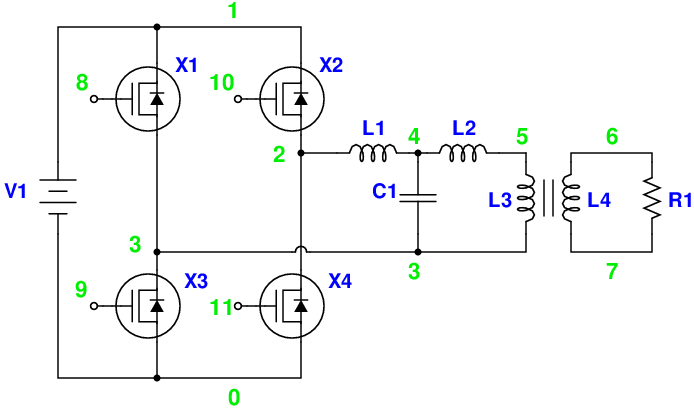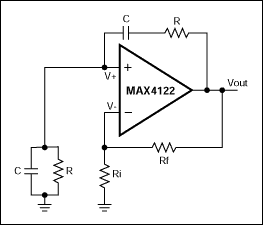
grundig 5040w3d circuitry analysis
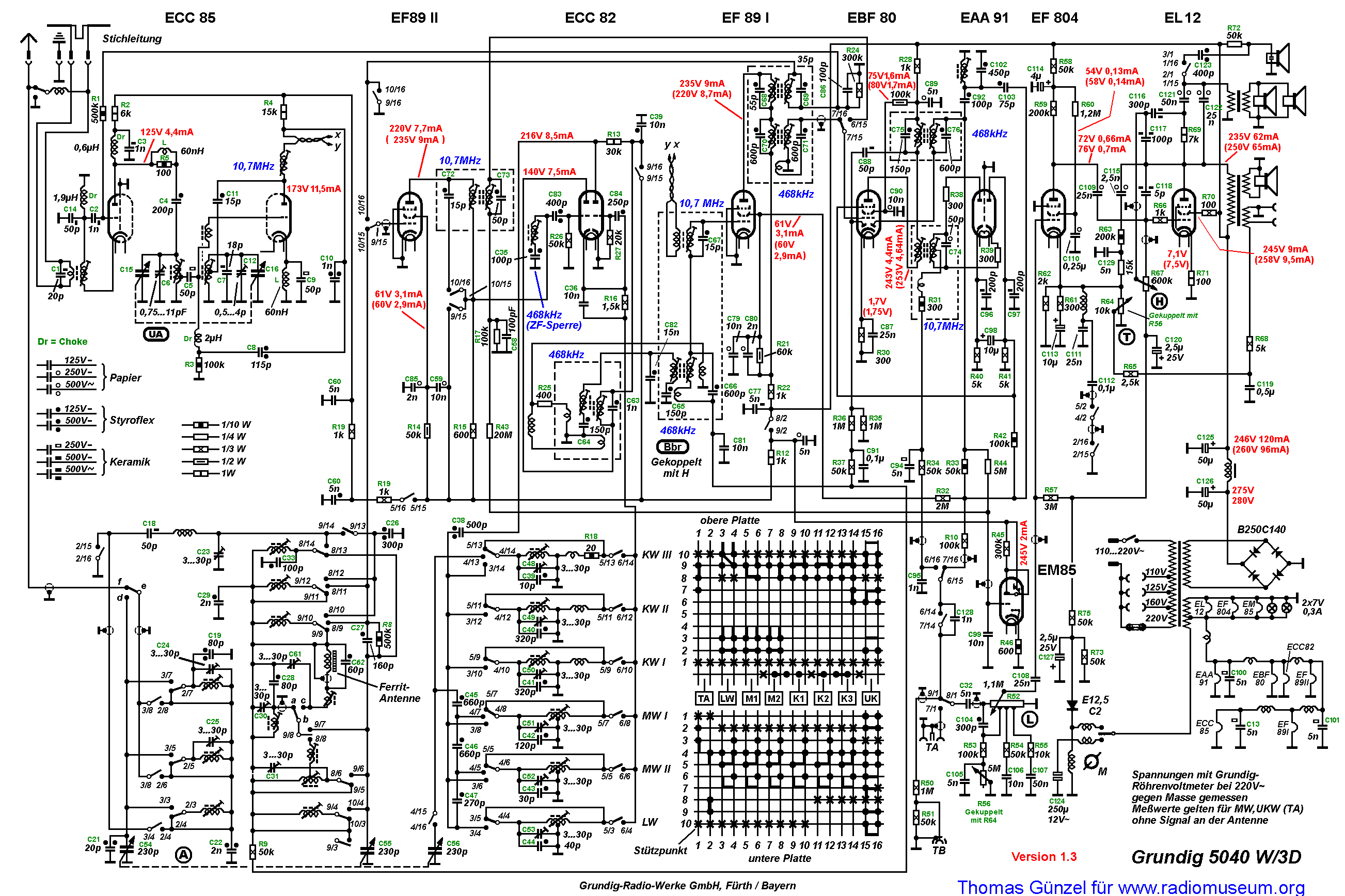
The primary winding of the first IF transformer lacks a capacitor, indicating that it functions as a single tuned circuit with the primary coil serving solely as an inductive coupling. The routing of the twisted pair cannot be replicated precisely every time. After assembling the complete set, it is uncertain whether it is necessary to readjust the coil in the tuner (located at the anode of the second section of the ECC85) or if merely adjusting the first IF transformer suffices. The twisted pair transmission line connecting the FM tuner to the first IF stage is designed to operate as a balanced (symmetric) transmission line with a nearly constant impedance. The characteristic impedance is influenced by the diameter of the wires and the distance between them, determined by the thickness of the insulation multiplied by two. The first IF transformer, featuring only one adjustable ferrite core, likely has tightly coupled primary and secondary windings, allowing the primary capacitance to be transformed to the secondary. The primary winding is essential for coupling the balanced feed line (the twisted pair) to the unbalanced grid circuit of the first IF stage, thus necessitating a transformer with a single tuned circuit and a coupling coil. Given that the FM tuner was previously aligned, no further adjustment of the output circuit of the ECC85 in the tuner is required after final assembly. For the initial alignment of the tuner, terminating the end of the twisted pair with a resistor matching the characteristic impedance of the transmission line is adequate. The inductance of the coupling coil is influenced by the position of the adjustable core in the IF transformer, which in turn is affected by the capacitance of C67, the wiring, and the subsequent tube. For optimal performance, a final adjustment of the coil in the FM tuner box is necessary and has indeed been performed. The feed line to the first IF transformer and the coupling coil in series contribute to the inductance of the anode circuit of the ECC85. When the first IF transformer is tuned to resonance, it behaves as a purely ohmic impedance (a pure resistance), which is also true for the coupling coil. Consequently, the feed line is terminated with a matched resistive load. This termination resistance, produced by the coupling coil and matching the characteristic impedance of the transmission line, ensures that there are no reflections on the twisted pair. In this scenario, the feed line appears to have its characteristic impedance, and this resistance is in series with the anode coil of the ECC85. If this information is accurate, the twisted pair influences the Q of the anode circuit and enhances its bandwidth. It is understood that for a high-quality product, the tuner would undergo final alignment adjustments. The question posed by Herr GG nzel is not clearly understood. The entire parallel circuit becomes ohmic at resonance, but each component continues to exhibit capacitance or damped inductance behavior. A significant reactive current flows between the capacitance and inductance due to the increased voltage at resonance. Thus, the complete combination of the transmission line and coupling coil is regarded as an inductance, which, along with the adjustable core, plays a crucial role in the overall performance of the circuit.
The described circuit involves a first IF transformer with a primary winding that serves as an inductive coupling without a capacitor, indicating a design choice that simplifies the tuning process. The coupling mechanism allows for efficient signal transfer from the FM tuner to the first IF stage while maintaining a balanced transmission line, which is crucial for minimizing signal loss and reflections. The characteristic impedance of the twisted pair is a critical parameter, as it ensures that the system operates optimally by matching the load to the source.
The adjustable ferrite core within the first IF transformer enables fine-tuning of the inductance, which is essential for achieving resonance. This resonance condition is critical as it transforms the impedance characteristics of the circuit, allowing the coupling coil to function effectively. The termination of the twisted pair with a resistor matching the characteristic impedance is a standard practice to prevent signal reflections, which can degrade performance.
The interaction between the coupling coil and the anode circuit of the ECC85 is significant, as it impacts the overall Q factor of the circuit, thereby influencing the bandwidth and selectivity of the tuner. The final adjustment of the coil ensures that the entire assembly operates within the desired specifications, thereby enhancing the quality of the received signal. The consideration of reactive components in the circuit underlines the complexity of RF design, where both inductive and capacitive elements play vital roles in circuit behavior at resonance. This comprehensive understanding of the circuit's operation is essential for optimizing performance in high-quality FM tuner designs.On the primary winding of the first IF transformer there is no capacitor. Does that mean it has only one tuned circuit, and the primary coil is just an inductive coupling The routing of the twisted pair couldn`t be done exactly the same every time. Was it necessary after assembly of the complete set to readjust the coil in the tuner (at the anode of the second section of the ECC85),
or was it sufficient to simply adjust the first IF transformer I`m looking forward to lively participation. Whoever doesn`t have access topost in this forum is welcome to send me (Thomas G. or Tom A. )questions by email. [To send an email to me (Tom A. ), click on "mail to the author" at the bottom of this thread. To send an email to Thomas G. , go the the German_thread and click on "mail to the author" at the bottom of the first post. ] The twisted pair transmission line between the FM tuner and the first IF stage is twisted so that it can serve as a balanced (symmetric) transmission line with nearly constant impedance.
The characteristic impedance is determined by the diameter of both wires and their distance from one another (in this case, the thickness of the insulation times two). The first IF transformer, which has only one adjustable ferrite core, I would assume has its primary and secondary winding tightly coupled, so thatthe primary capacitance is transformed to the secondary.
The primary winding is necessary in order to couple the balanced feed line (the twisted pair) to the unbalanced grid circuit of the first IF stage. Therefore a transformer with a single tuned circuit and a coupling coil is used. Given that the FM tuner was previously aligned, no additional readjustment of the output circuit of the ECC85 in the tuner is necessary after final assembly.
For the previous alignment of the tuner, it would be sufficient to terminate the end of the twisted pair with a resistor matching the characteristic impedance of the transmission line. Your answer is also accepted. As can be seen in the following text, it`s a matter of how you see things with respect to the question: Since it was previously aligned, does get get aligned again or not The inductance of the coupling coil, however, is affected by the position of the adjustable core in the IF transformer, and the position of the core in turn depends on the capacitance of C67, the wiring, and the next tube.
For top-notch performance, a final adjustment of the coil in the FM tuner box is necessary, and was actually done. As you have shown, the feedline to the first IF transformer and the coupling coil in series with it form part of the inductance of the anode circuit of the ECC85.
If the first IF transformer is tuned to resonance it becomes a purely ohmic impedance (a pure resistance), and as a result, this is true of the coupling coil too. Therefore the feedline is terminated with a matched resistive load. Therefore, the termination resistance, which is created by the coupling coil and which matches the characteristic impedance of the transmission line means that there will be no relectinos on the twisted pair.
In this case, the feedline simply looks like its characteristic impedance, and this R is in series with the anode coil of the ECC85. If all of this is correct, then the twisted pair simply affects the Q of the anode circuit and increases its bandwidth.
Of course it`s clear to me, that for a high quality product, the tuner would be adjusted as part of a final alignment. Therefore I didn`t understand the question by Herr GG nzel. Only the parallel circuit as a whole becomes ohmic at resonance. Each of its components continues to behave as a capacitance or a (damped) inductance. In particular, a rather large reactive current flows between the C and L, because of the increased voltage at resonance.
Therefore I view the complete combination of the transmission line and coupling coil as an inductance, which together with the adju 🔗 External reference
The described circuit involves a first IF transformer with a primary winding that serves as an inductive coupling without a capacitor, indicating a design choice that simplifies the tuning process. The coupling mechanism allows for efficient signal transfer from the FM tuner to the first IF stage while maintaining a balanced transmission line, which is crucial for minimizing signal loss and reflections. The characteristic impedance of the twisted pair is a critical parameter, as it ensures that the system operates optimally by matching the load to the source.
The adjustable ferrite core within the first IF transformer enables fine-tuning of the inductance, which is essential for achieving resonance. This resonance condition is critical as it transforms the impedance characteristics of the circuit, allowing the coupling coil to function effectively. The termination of the twisted pair with a resistor matching the characteristic impedance is a standard practice to prevent signal reflections, which can degrade performance.
The interaction between the coupling coil and the anode circuit of the ECC85 is significant, as it impacts the overall Q factor of the circuit, thereby influencing the bandwidth and selectivity of the tuner. The final adjustment of the coil ensures that the entire assembly operates within the desired specifications, thereby enhancing the quality of the received signal. The consideration of reactive components in the circuit underlines the complexity of RF design, where both inductive and capacitive elements play vital roles in circuit behavior at resonance. This comprehensive understanding of the circuit's operation is essential for optimizing performance in high-quality FM tuner designs.On the primary winding of the first IF transformer there is no capacitor. Does that mean it has only one tuned circuit, and the primary coil is just an inductive coupling The routing of the twisted pair couldn`t be done exactly the same every time. Was it necessary after assembly of the complete set to readjust the coil in the tuner (at the anode of the second section of the ECC85),
or was it sufficient to simply adjust the first IF transformer I`m looking forward to lively participation. Whoever doesn`t have access topost in this forum is welcome to send me (Thomas G. or Tom A. )questions by email. [To send an email to me (Tom A. ), click on "mail to the author" at the bottom of this thread. To send an email to Thomas G. , go the the German_thread and click on "mail to the author" at the bottom of the first post. ] The twisted pair transmission line between the FM tuner and the first IF stage is twisted so that it can serve as a balanced (symmetric) transmission line with nearly constant impedance.
The characteristic impedance is determined by the diameter of both wires and their distance from one another (in this case, the thickness of the insulation times two). The first IF transformer, which has only one adjustable ferrite core, I would assume has its primary and secondary winding tightly coupled, so thatthe primary capacitance is transformed to the secondary.
The primary winding is necessary in order to couple the balanced feed line (the twisted pair) to the unbalanced grid circuit of the first IF stage. Therefore a transformer with a single tuned circuit and a coupling coil is used. Given that the FM tuner was previously aligned, no additional readjustment of the output circuit of the ECC85 in the tuner is necessary after final assembly.
For the previous alignment of the tuner, it would be sufficient to terminate the end of the twisted pair with a resistor matching the characteristic impedance of the transmission line. Your answer is also accepted. As can be seen in the following text, it`s a matter of how you see things with respect to the question: Since it was previously aligned, does get get aligned again or not The inductance of the coupling coil, however, is affected by the position of the adjustable core in the IF transformer, and the position of the core in turn depends on the capacitance of C67, the wiring, and the next tube.
For top-notch performance, a final adjustment of the coil in the FM tuner box is necessary, and was actually done. As you have shown, the feedline to the first IF transformer and the coupling coil in series with it form part of the inductance of the anode circuit of the ECC85.
If the first IF transformer is tuned to resonance it becomes a purely ohmic impedance (a pure resistance), and as a result, this is true of the coupling coil too. Therefore the feedline is terminated with a matched resistive load. Therefore, the termination resistance, which is created by the coupling coil and which matches the characteristic impedance of the transmission line means that there will be no relectinos on the twisted pair.
In this case, the feedline simply looks like its characteristic impedance, and this R is in series with the anode coil of the ECC85. If all of this is correct, then the twisted pair simply affects the Q of the anode circuit and increases its bandwidth.
Of course it`s clear to me, that for a high quality product, the tuner would be adjusted as part of a final alignment. Therefore I didn`t understand the question by Herr GG nzel. Only the parallel circuit as a whole becomes ohmic at resonance. Each of its components continues to behave as a capacitance or a (damped) inductance. In particular, a rather large reactive current flows between the C and L, because of the increased voltage at resonance.
Therefore I view the complete combination of the transmission line and coupling coil as an inductance, which together with the adju 🔗 External reference
